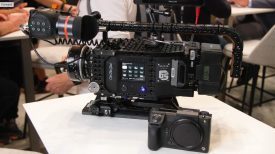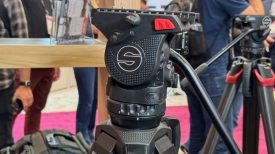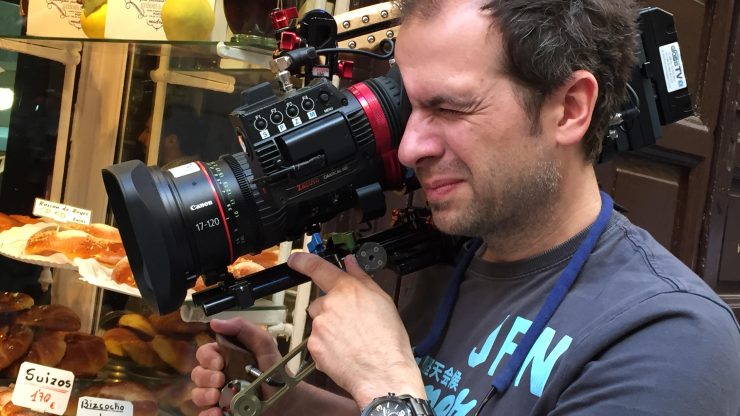
The majority of my work is in factual television using a number of different large sensor cameras including Canon C300s, Sony F5/F55s and DSLRs.
Unlike traditional 2/3” sensor ENG cameras, which have a shoulder mount built into the design, most large sensor cameras don’t. To get decent handheld shots you really need a rig that balances well on your shoulder. I also need one that’s transferable between the different camera systems I use. Over the years I have tried different rig combinations from a number of manufacturers, but have never found a set up that works really well. This has made me reluctant to do long handheld shots.
So when I visited the Zacuto booth at a trade show I was very intrigued to try their VCT Universal Baseplate.
As its name suggests, what’s great about it is that it fits practically all large sensor cameras on the market. It has a v-wedge tripod connector based around the very familiar Sony VCT-14 quick release baseplate which older users will remember from their Betacam days. The Universal baseplate fits securely into the genuine Sony VCT plate, but be aware that some inferior plastic copies of the VCT 14 plate are on the market and these don’t fit as well. I personally have had no problems but I’m aware of users who do (and not just interfacing with the Zacuto’s VCT but other makers’ solutions too). Alternatively, you can attach the baseplate directly onto the regular quick-release plate of your tripod if you prefer – although this can make the rig back-heavy.
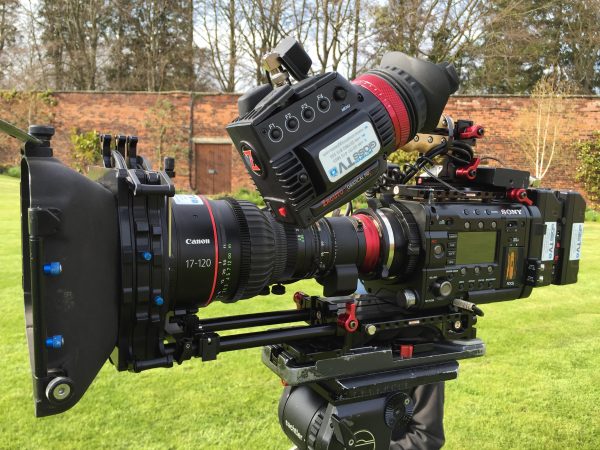
On the rear of the Zacuto VCT baseplate are two threaded 15mm rod ports. This is very handy if you want to mount accessories like an external battery or radio mic receivers. On both sides of the baseplate there are rows of screw holes, so again you have the option to mount accessories or Zacuto’s NATO rail quick-release system.
One of the key issues with shoulder rigs is finding a good balance point. Many super35 sensor cameras, especially DSLRs, are light and small – but the high quality lenses I tend to use, especially cine zooms, are often weighty and can make them very front-heavy. Zacuto suggest that often the point where the lens meets the body should be placed directly over your shoulder to ensure good balance. Add a larger lens or a heavier battery and that point will of course change.
To achieve good balance the camera itself needs to be able to be positioned backwards or forwards on the plate to account for the changing centre of gravity of different combinations of kit. With this in mind Zacuto have designed the baseplate so that the camera can slide backwards or forwards along a central screw slot, then tightened down when it reaches the right position. You can use multiple screws for a more secure mounting if your camera has the appropriate holes on its base. I have noticed that adjusting the position of the camera once it is on the baseplate can take a little time because the screw slot is partially obscured by the shoulder pad, so that getting a screwdriver in to make adjustments is trickier than it perhaps should be. Newer versions of the VCT baseplate have markings that allow you to make a note of where the camera is placed when in different configurations.
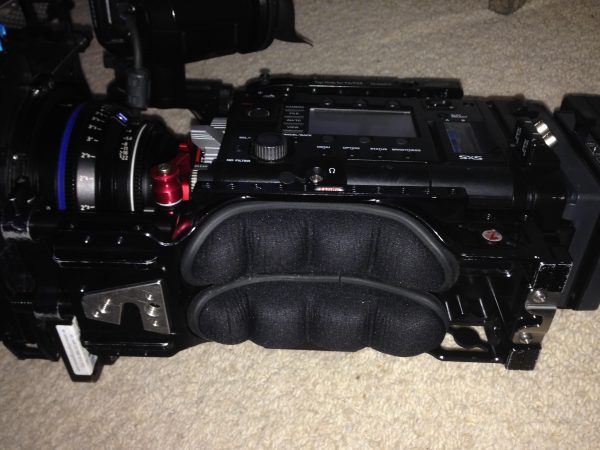
That shoulder pad is made up of two gel polymer sections that mould to your shoulder and is the most comfortable I have found. The baseplate is also quite thin and the distance between the base of the camera and the shoulder pad is 0.75 inches. This helps to ensure that the camera doesn’t swing around unduly and makes it feel that the baseplate is an integrated part of the camera with the lowest possible centre of gravity.
However, there is a slight trade-off to achieving perfect balance. The camera often has to be placed so far back on your shoulder that it is virtually behind you. Controls that you might need to access regularly can be next to your head or out of reach altogether. Holding the camera with whatever handgrip it came with is also unlikely to work – you need to either relocate this using a Zacuto grip relocator (they make them for Canon C100/300 and some Sony cams), or add extra hand grips / moose bars. Depending on how far back your lenses end up you may also need to add a follow focus to prevent having your focusing hand being stuck up near your face all the time.
The base plate comes with a pair of 6.5” 15mm rods as standard and Zacuto have designed the adjustable rod mount so ‘it is set as far back as possible on the plate, to maximize your accessory capable rod area and aid with balance.’ But if, like me, you are using a rod-mounted matte box and multiple lenses of different physical lengths, you may need different length rods for each type of lens you use. This can be a pain if constantly changing between cine primes, zooms and stills lenses.
With a short lens like a Zeiss CP.2 prime fitted and a 15mm bar-mounted matte box, I have found there is virtually no spare space on the rods directly under the lens in order to mount a traditional follow focus. I have also discovered that some follow focus units can butt up against the side of my matte box. There are a few solutions for this which I have yet to try; a compact clip-on matte box like the Bright Tangerine Misfit Atom would probably help in this situation. Zacuto’s own Z-drive follow focus has a unique design that means it takes up less rod space than others. Alternatively you could mount rods to the top of your camera and hang a follow or remote focus system like the Redrockmicro Remote from that instead.
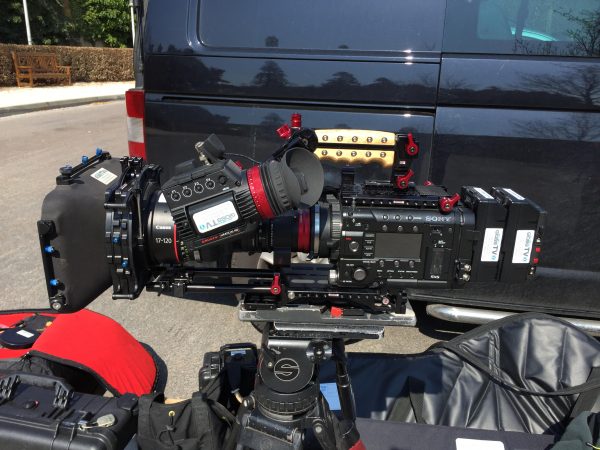
Sometimes to get the Zeiss CP2’s to fit with a matte box I have had to compromise on the balance by having the camera slightly further forward on the baseplate. To then compensate for the camera being slightly too far forward, I have to add an extra battery on the back of the camera or rig.
Another solution is to stick to larger cine zoom lenses. If using a longer lens like the Canon CN7 there is plenty of rod space where you can add follow focus and lens support.
I have now used the Zacuto shoulder mount for a number of months on many shoots and I have been very impressed. I think it is robust, well built, lightweight and very comfortable: it’s an ideal purchase for anyone who regularly uses different cameras. The issue with rod space when fitting smaller lenses with a matte box and follow focus is annoying but workable. I do wish that the screws on the underside of the plate would be easier to slide and reattach to the camera to allow faster rebalancing after a lens change – especially important during a documentary shoot. Overall, though, the Zacuto VCT Universal Baseplate is still a great addition to my kit.



